News Release from Fraunhofer-Institut für Windenergiesysteme IWES
Wind Industry Profile of
Germany: Manufacturing center for rotor blades starts operation
The manufacturing of rotor blades still demands a high degree of manual labor. This is due to the low piece numbers in a production series compared to the automotive industry for example: Whilst in the latter sector, models roll off the line hundreds of thousands of times, the tool mold for a rotor blade is only used as a template a few hundred times. Yet, for manufacturers, the ability to produce parts more quickly and with a constantly higher level of precision can result in significant cost advantages. Together with 15 partners, the Fraunhofer IWES has coordinated the development of a manufacturing center which was inaugurated today in Bremerhaven. Thanks to special portals, in future eight process steps will be performed at one machine station in order to render the workflows more efficient.
The chips really did fly at this launch! As part of the official opening of the BladeMaker center, 150 representatives from the industry got the chance to watch the milling of a tool mold for a 40-meter blade. Scientists, rotor blade and component manufacturers, providers of production controls, and material suppliers have been working together on the concept and process development for three and a half years with the goal of advancing the manufacturing of rotor blades from small-series to major industrial production. The initial goal is to achieve savings of minimum 10 percent through more efficient production processes, the use of innovative materials and carefully selected automation approaches.
Contrary to the general trend in composite manufacturing, linear drives with additional rotational degrees of freedom are preferred to a robot solution. A verified cost model that has been developed in close collaboration with a large number of blade manufacturers has confirmed the feasibility of this aim. The demonstration center is open to all interested industrial companies for production-related testing.
Integrated machine concept
The L-shaped design of both gantry robots offers two crucial advantages: Loading and unloading from the side is possible and the rotor blade can still be accessed by technicians for performing additional work. Given the structural design of this former building, integrating the system presented no problems whatsoever. The lightweight gantry robot system combines the precision of a milling machine with a load-bearing capacity of up to 500 kg. “As such, we can perform various steps, which would normally be conducted at different machines, at the same work station by simply changing the process head,” explained Christian Dörsch, Group Leader for Manufacturing at Fraunhofer IWES.
Exceptional functionality and operational comfort
Various process heads can be attached to each of the two gantry robots which work either independently or in parallel. They move along the lines at a maximum speed of 2.5 m/second. A heavy-load platform for transporting the semi-finished products and materials is towed along the floor to facilitate the setting up of the gantry robots. The CNC control from one of the project partners allows the design and production stage to be linked. Given the structural design of the facility, integrating the system presented no problems whatsoever.
Full-scale demonstration with optimized blade
IWES scientists will continue to examine manufacturing and process technologies in order to identify the ideal blade design for industrialized production until fall 2017. The next milestone is the manufacture of a model blade which will pass through the various production steps. This will provide an opportunity to identify areas for improvement as well as compare and assess results.
The results of the BladeMaker project will give quality-conscious manufacturers a competitive edge and, ultimately, also render the generation of wind energy more cost-efficient. The project is being funded by the Federal Ministry for Economic Affairs and Energy to the tune of around 8 million euros.
- Source:
- IWES
- Link:
- www.windenergie.iwes.fraunhofer.de/...


